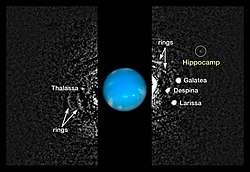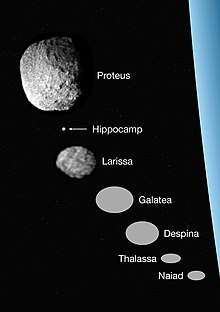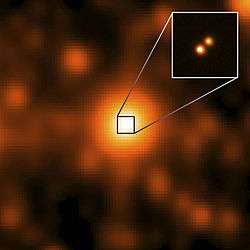Hippocamp (moon)
Hippocamp, originally known as S/2004 N 1, is a small moon of Neptune, about 35 km (20 mi) in diameter, which orbits the planet in about 23 hours, just under one Earth day. Its discovery on 1 July 2013 increased the number of Neptune's known satellites to fourteen.[8] The moon is so dim that it was not observed when the Voyager 2 space probe flew by Neptune and its moons in 1989. Mark Showalter of the SETI Institute found it by analyzing archived Neptune photographs the Hubble Space Telescope captured between 2004 and 2009. The moon was formally numbered Neptune XIV (14) on 25 September 2018 in Minor Planet Circular 111804, and named Hippocamp in February 2019.
 Composite of Hubble images from 2009 showing Neptune, its rings, and inner moons including Hippocamp (circled)[lower-alpha 1] | |
| Discovery[1] | |
|---|---|
| Discovered by | M. R. Showalter I. de Pater J. J. Lissauer R. S. French |
| Discovery date | 1 July 2013 |
| Designations | |
Designation | Neptune XIV |
| Pronunciation | /ˈhɪpəkæmp/[2] |
Named after | ἱππόκαμπος hippokampos |
| S/2004 N 1 | |
| Adjectives | Hippocampian /hɪpəˈkæmpiən/[3] |
| Orbital characteristics[4] | |
| Epoch 1 January 2020 (JD 2458849.5) | |
| 105,283 km | |
| Eccentricity | 0.00048±0.00032[5] |
| 0.95 d (22.8 h) | |
| 240.98° | |
| Inclination | 0.0641°±0.0507° (to Neptune's equator)[5] 0.002° (to local Laplace plane)[4] |
| 110.467° | |
| 234.48° | |
| Satellite of | Neptune |
| Physical characteristics | |
Mean radius | 17.4±2.0 km[5] |
| Mass | (1.029–30.87)×1015 kg[4] |
Mean density | ≈1.3 g/cm3 (assumed)[6] |
| synchronous | |
| Albedo | ≈0.09 (assumed)[5] |
| 26.5±0.3[7][6] | |
History
Discovery
Hippocamp was discovered by a team of astronomers led by Mark Showalter of the SETI Institute on 1 July 2013. Showalter was examining archival Hubble Space Telescope images of Neptune from 2009, as part of his study on the ring arcs of Neptune. Since the inner moons and ring arcs of Neptune orbit quickly, Showalter developed and used a technique similar to panning, where multiple short-exposure images are gathered and digitally offset to compensate for orbital motion and to allow stacking of multiple images to bring out faint details.[8][9] On a whim, Showalter decided to extend his analysis to regions beyond Neptune's ring system; he then found Hippocamp as a faint but unambiguous white dot.[8][10]
To confirm the moon, Showalter further analyzed over 150 archival Hubble images going back to 2004.[8] Within a week, Showalter repeatedly found Hippocamp in these images and was able to identify the moon at ten different observation times from 2004 to 2009.[7][11] Showalter had also checked images from the Voyager 2 spacecraft to find any detections of Hippocamp during its 1989 Neptune flyby, but was unable to identify the moon since it was too dim to be detected by Voyager 2's cameras. Nonetheless, the number of archival Hubble images with Hippocamp was enough to determine the moon's orbit.[8][7][10] The discovery of Hippocamp was formally announced in a notice issued by the International Astronomical Union's Central Bureau for Astronomical Telegrams (CBET), along with a press release by the Space Telescope Science Institute on 15 July 2013.[7][8] Given that the relevant images examined by Showalter were available to the public, the discovery could have been made by anyone.[10]
Naming
The moon is named after the hippocampus, a mythological creature depicted as having the upper body of a horse with the lower body of a fish in Greek mythology.[12] The hippocampus symbolizes the Greek sea god Poseidon as well as the Roman sea god Neptune.[13][12] In Roman mythology, Neptune would often drive a sea-chariot pulled by hippocampi.[12]
Upon the announcement of its discovery, the moon was given the provisional designation S/2004 N 1. The provisional designation indicates that it was the first Neptunian satellite to be identified in images dating from 2004.[7] Follow-up Hubble observations of Hippocamp were conducted by Showalter in 2016, and the moon was later given its permanent Roman numeral designation by the Minor Planet Center after its recovery.[14][15] Hippocamp was formally numbered as Neptune XIV (14) on 25 September 2018, though it remained without an official name until February 2019.[15]
By the International Astronomical Union's (IAU's) nomenclature guidelines, name proposals for Neptune's moons must be based on a figure from Greco-Roman mythology with a relationship to Poseidon or Neptune.[13][16] Showalter and his team had sought for names since the announcement of their discovery; among the names considered was Polyphemus, the gigantic one-eyed son of Poseidon and Thoosa.[17] Showalter then settled on the name Hippocamp in acknowledgement of the seahorse genus, Hippocampus, mainly for his passion for scuba diving and the animal itself.[18] Showalter's name proposal was approved by the IAU's naming committee on 20 February 2020, and the name was announced in a press release by the Space Telescope Science Institute.[19][16]
Origin

Neptune's largest moon, Triton, has a retrograde and inclined orbit. It is hypothesized that Neptune captured it from the Kuiper belt well after Neptune's original satellite system formed. The pre-existing moons' orbits would have been shifted by this event, leading to the ejection of some moons and the collisional destruction of others.[20][21] At least some of Neptune's present inner satellites are thought to have then accreted from the resulting rubble after Triton's orbit was circularized by tidal deceleration.[22]
Another hypothesis suggests that Hippocamp may have formed specifically out of debris from the nearest moon of Neptune, the much larger Proteus.[5] The debris was possibly ejected by the comet impact that formed its largest crater Pharos; this ejecta would have had about 50 times greater volume than Hippocamp. Hippocamp orbits relatively close to Proteus; their semi-major axes differ by about 12,000 km. Hippocamp probably formed within a few thousand kilometres from Proteus; Proteus would then have gradually receded from it due to its much stronger tidal interaction with Neptune.[5]
Physical characteristics
.jpg)
Hippocamp is assumed to resemble Neptune's other inner satellites in having a dark surface.[5] Their geometrical albedos range from 0.07 to 0.10.[23] Derived from Hippocamp's apparent magnitude of 26.5, its diameter was initially thought to be around 16 to 20 km, making it the smallest of Neptune's known moons. More recent observations of Neptune's moons have shown that Hippocamp is almost twice as large as previously thought, giving it a diameter of 34.8 km.[5] However, it remains by a wide margin the smallest of Neptune's inner, regular, satellites.
The near-infrared spectra of Neptune's rings and inner moons have been examined with the HST NICMOS instrument.[24][25] Similar dark, reddish material, characteristic of small outer Solar System bodies, appears to be present on all their surfaces. The data is consistent with organic compounds containing C−H and/or C≡N bonds,[25] but spectral resolution was inadequate to identify the molecules. Water ice, abundant in the outer Solar System, is believed to be present, but its spectral signature could not be observed (unlike the case of small Uranian moons).[25]
Orbital properties

Hippocamp completes one revolution around Neptune every 22 hours and 28.1 minutes (0.95 days), implying a semi-major axis, or orbital distance of 105,283 km (65,420 mi), just over a quarter that of Earth's Moon, and roughly twice the average radius of Neptune's rings. Both its inclination and eccentricity are close to zero.[4] It orbits between Larissa and Proteus, making it the second outermost of Neptune's regular satellites. Its small size at this location runs counter to a trend among the other regular Neptunian satellites of increasing diameter with increasing distance from the primary.[6]
The periods of Larissa and Hippocamp are within about one percent of a 3:5 orbital resonance,[lower-alpha 2] while Hippocamp and Proteus are nearly in a 11:13 resonance.[4] Larissa and Proteus are thought to have passed through a 1:2 mean-motion resonance a few hundred million years ago.[26][27] Proteus[26] and Hippocamp have drifted away from Larissa since then because the former two are outside Neptune-synchronous orbit (Neptune's rotational period is 0.67 days or 16.1 hours) and are thus being tidally accelerated, while Larissa is within and is being tidally decelerated.[26]
Notes
- The relative brightness of the moons is exaggerated in this composite of high and low exposure images. The color image of Neptune was taken separately by Hubble in August 2009.
- Given the moons' respective periods of 0.55465 and 0.95 days, the actual ratios are 2.92:5.00.
References
- "Planetary Satellite Discovery Circumstances". Jet Propulsion Laboratory. 28 October 2019. Retrieved 21 June 2020.
- "Hippocamp". Merriam-Webster Dictionary.
- Anon. (1899) "Invocation to Neptune", Poems, New York, p. 84
- Brozović, M.; Showalter, M. R.; Jacobson, R. A.; French, R. S.; Lissauer, J. J.; de Pater, I. (March 2020). "Orbits and resonances of the regular moons of Neptune". Icarus. 338 (113462). arXiv:1910.13612. Bibcode:2020Icar..33813462B. doi:10.1016/j.icarus.2019.113462.
- Showalter, M. R.; de Pater, I.; Lissauer, J. J.; French, R. S. (February 2019). "The seventh inner moon of Neptune". Nature. 566 (7744): 350–353. Bibcode:2019Natur.566..350S. doi:10.1038/s41586-019-0909-9. PMC 6424524. PMID 30787452.CS1 maint: date and year (link)
- "Planetary Satellite Physical Parameters". Jet Propulsion Laboratory. 19 February 2015. Retrieved 21 June 2020.
- "New Satellite of Neptune: S/2004 N 1" (PDF). Central Bureau Electronic Telegrams. International Astronomical Union. 15 July 2013. Bibcode:2013CBET.3586....1S. Retrieved 21 June 2020.
- "Hubble Finds New Neptune Moon". HubbleSite. Space Telescope Science Institute. 15 July 2013. Retrieved 15 July 2013.
- Grossman, Lisa (15 July 2013). "Neptune's strange new moon is first found in a decade". NewScientist. Retrieved 18 July 2013.
- Beatty, Kelly (15 July 2013). "Neptune's Newest Moon". Sky & Telescope. Retrieved 12 June 2017.
- Showalter, Mark (15 July 2013). "How to Photograph a Racehorse …and how this relates to a tiny moon of Neptune". Cosmic Diary. Retrieved 16 July 2013.
- "Hubble helps uncover origin of Neptune's smallest moon Hippocamp". Spacetelescope.org. European Space Agency. 20 February 2019. Retrieved 21 February 2019.
- "Planet and Satellite Names and Discoverers". Gazetteer of Planetary Nomenclature. USGS Astrogeology Science Center. Retrieved 22 June 2020.
- Showalter, Mark (October 2015). "Neptune's Evolving Inner Moons and Ring-Arcs". Mikulski Archive for Space Telescopes. Space Telescope Science Institute. Bibcode:2015hst..prop14217S. Retrieved 25 June 2020.
- "M.P.C. 111804" (PDF). Minor Planet Circular. Minor Planet Center. 25 September 2018. Retrieved 25 June 2020.
- "Tiny Neptune Moon Spotted by Hubble May Have Broken from Larger Moon". HubbleSite. Space Telescope Science Institute. 20 February 2019. Retrieved 22 June 2020.
- Billings, Lee (18 July 2013). "Neptune's New Moon May Be Named after One of Sea God's Monstrous Children". Scientific American. Retrieved 25 June 2020.
- Beatty, Kelly (20 February 2019). "Meet Hippocamp, Neptune's Smallest Moon". Sky & Telescope. Retrieved 25 June 2020.
- "Name Approved for Neptunian Satellite: Hippocamp". Gazetteer of Planetary Nomenclature. USGS Astrogeology Science Center. 20 February 2019. Retrieved 22 June 2020.
- Goldreich, P.; Murray, N.; Longaretti, P. Y.; Banfield, D. (August 1989). "Neptune's Story". Science. 245 (4917): 500–504. Bibcode:1989Sci...245..500G. doi:10.1126/science.245.4917.500. PMID 17750259.
- Agnor, Craig B.; Hamilton, Douglas P. (May 2006). "Neptune's capture of its moon Triton in a binary–planet gravitational encounter". Nature. 441 (7090): 192–194. Bibcode:2006Natur.441..192A. doi:10.1038/nature04792. PMID 16688170.
- Banfield, Don; Murray, Norm (October 1992). "A dynamical history of the inner Neptunian satellites". Icarus. 99 (2): 390–401. Bibcode:1992Icar...99..390B. doi:10.1016/0019-1035(92)90155-Z.
- Karkoschka, Erich (April 2003). "Sizes, shapes, and albedos of the inner satellites of Neptune". Icarus. 162 (2): 400–407. Bibcode:2003Icar..162..400K. doi:10.1016/S0019-1035(03)00002-2.
- Dumas, C.; Terrile, R. J.; Smith, B. A.; Schneider, G. (March 2002). "Astrometry and Near-Infrared Photometry of Neptune's Inner Satellites and Ring Arcs". The Astronomical Journal. 123 (3): 1776–1783. Bibcode:2002AJ....123.1776D. doi:10.1086/339022. ISSN 0004-6256.
- Dumas, C.; Smith, B. A.; Terrile, R. J. (August 2003). "Hubble Space Telescope NICMOS Multiband Photometry of Proteus and Puck". The Astronomical Journal. 126 (2): 1080–1085. Bibcode:2003AJ....126.1080D. doi:10.1086/375909. ISSN 0004-6256.
- Zhang, K.; Hamilton, D. P. (June 2007). "Orbital resonances in the inner neptunian system: I. The 2:1 Proteus–Larissa mean-motion resonance". Icarus. 188 (2): 386–399. Bibcode:2007Icar..188..386Z. doi:10.1016/j.icarus.2006.12.002. ISSN 0019-1035.
- Zhang, K.; Hamilton, D. P. (January 2008). "Orbital resonances in the inner neptunian system: II. Resonant history of Proteus, Larissa, Galatea, and Despina". Icarus. 193 (1): 267–282. Bibcode:2008Icar..193..267Z. doi:10.1016/j.icarus.2007.08.024. ISSN 0019-1035.
External links
| Wikimedia Commons has media related to Hippocamp (moon). |
- Hippocamp In Depth, NASA Solar System Exploration, updated 19 December 2019
- A new moon for Neptune, Anne J. Verbiscer, Nature, 20 February 2019
- How to Photograph a Racehorse …and how this relates to a tiny moon of Neptune, Mark Showalter, Cosmic Diary (Mark Showalter's Blog), 15 July 2013
![]()

_flatten_crop.jpg)


